
voronina_ev_sotsialnokulturnaia_sfera_obshcheniia
.pdf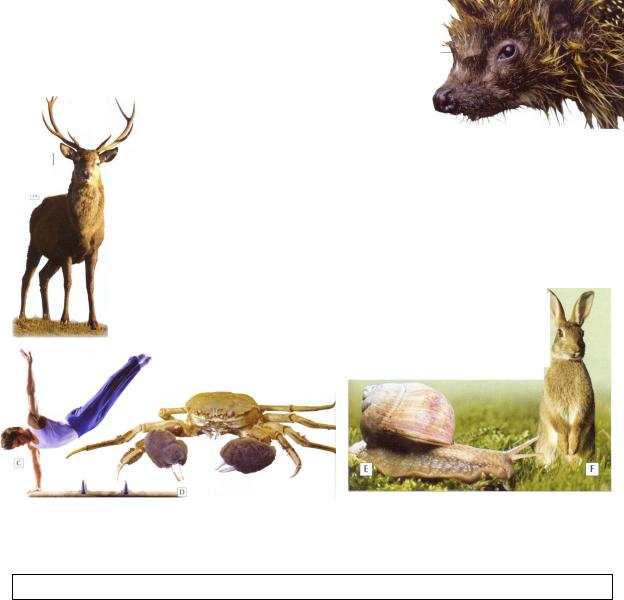
1.Lead-in
1.a Which of these animals can you see in the photos?
crab red deer elephant giraffe
gorilla hedgehog human leopard monkey panda rabbit snail squirrel tiger
1.b Which of the animals above do you have in your country? Which do you think are cute? Are any of them dangerous? Are any of them nearly extinct?
2.Reading
2.a Pre-reading activity
Look at the headline of the article below. What do you think the article is about?
2.b While-reading activity
Read the article and find out where these animals came from, where they invaded and who or what they caused problems for.
21
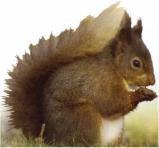
1 grey squirrels
2 red deer
3rabbits
4apple snails 5 mitten crabs
ANIMALINVADERS
Hоwmuchdangerarewein?Howmanymoanersarethere?
Imagine you run a small food shop in your local neighbourhood. Suddenly, a giant supermarket opens for business opposite your shop. What happens to you and your business?
In the natural world, things are often the same. The red squirrel was living happily in England when, in the 1880s, many people brought grey squirrels from North America as pets. Since then, these pets have escaped into the wild. They now eat the same food as the red squirrels, and they eat it more quickly. Consequently, now there aren't many native squirrels in England and they are in danger of extinction.
There are many invaders that don't cause extinctions, but they do destroy plants and harm the economy. For example, European red deer are destroying the forests in South America because they eat the young trees. Rabbits have spread from Europe and now eat farmers' crops all over the world. These kinds of invaders are causing problems for humans, unlike the grey squirrels,
which cause little damage to plants and don't damage the economy.
Few invaders are large land animals; most of them are fish or small animals like insects. There are thousands of these invaders and these smaller animals often mean farmers lose a lot of money. The apple snail from South America doesn't cause much damage in Europe, but it causes a lot of damage in southeast Asia because it loves to eat rice plants.
There are very few positive sides to these animal invasions. However, in Britain today, one invasion story offers some hope. Chinese mitten crabs first came on ships from China. These crabs destroy local environments and attack fish in fish farms. However, in China these crabs are an expensive food, so, now, Britain is selling them back to China. The crabs are travelling on ships again, but this time they are food, not invaders; and this time they are helping the British economy, not harming it.
22

2.c Post-reading activity
Read the article again and answer these questions.
1 |
What do you think happens to the |
5 |
Are there more large animal |
small food shop when a supermarket |
invaders than small ones? |
||
starts business? |
6 |
Why do you think the apple snail |
|
2 |
Is the red squirrel like the small |
doesn’t cause many problems in |
|
shop or the supermarket? |
Europe? |
||
3 |
Why did the grey squirrel come to |
7 |
Is it common to find good things |
Britain? |
about animal invasions? |
||
4 |
Do all invasive animals cause the |
8 |
Who is Britain selling mitten |
extinction of native animals? |
|
crabs to, and why? |
|
3. Language skills
Grammar: Expressing Quantity
3.a We can use a lot of with both countable and uncountable nouns. It means a large number or quantity. How do we use the other words in the box? Find and underline examples in the text.
a lot of few little many much
3.b Are these statements true or false? Use the examples you underlined in the text to help you.
1 We never use much in questions.
2 We often use many in positive sentences.
3 We don’t usually use much in positive sentences.
Instead, we use a lot of.
4 We never use much in negative sentences.
5 We can use many in questions and negative sentences.
3.c Complete this paragraph with much, many, a lot of, little or few.
There are many or a lot of animals that
are invaders, |
but perhaps there are |
2) ________ |
, if any, invaders that are |
worse than humans. 200,000 years ago there were very 3) __________
humans. Now there are nearly six billion of them. Unfortunately, there isn't 4) _________ information about the early history of this species, but it seems certain that the first humans
came from Ethiopia |
in east Africa. |
After 5) ___________ |
thousands of |
year (150-180) humans were living on every continent on Earth. How 6)
_________ damage have these invaders caused? They have destroyed 7) _____________ native plants and animals. Before humans, there was 8)
__________ pollution. Now, there is 9)
_________ pollution and it is causing 10) ___________ harm to the global environment. It seems that humans need to change things about their lifestyle if they want to survive.
3.d Use the sentence beginnings (or similar ones) to make true sentences about you.
23
In my country, there are many/is a lot of…
In my country, there are few/ is little…
In my house, there are many/ a lot of…
In my house, there aren’t many/isn’t much…
I’ve got many/a lot of…
I haven’t got many/much… I spend a lot of time…
I spend little…
3.e Ask your partner questions to find out if his/her life is similar to yours.
Have you got many pictures in your house?
Comparative – Superlative Degree
3.f Complete the table, then say how we form the comparative and superlative forms of adjectives and adverbs.
|
Comparative |
Superlative |
cheap |
cheaper |
………………………. |
large |
………………………. |
the largest |
big |
bigger |
………………………. |
noisy |
noisier |
………………………. |
busy |
………………………. |
the busiest |
expensive |
more expensive |
………………………. |
dangerous |
………………………. |
the most dangerous |
good |
………………………. |
the best |
bad |
………………………. |
the worst |
much/many |
more |
………………………. |
little |
………………………. |
the least |
far |
………………………. |
the farthest/the furthest |
3.g Look at the sentences. How do we form comparisons? When do we use as…as? When do we use than? When do we use more/less +adjective?
Cows are as big as horses. |
Snakes are more dangerous than |
Seals aren’t as smart as dolphins. |
spiders. |
Alligators are longer than lizards. |
Spiders are less dangerous than |
|
snakes. |
24
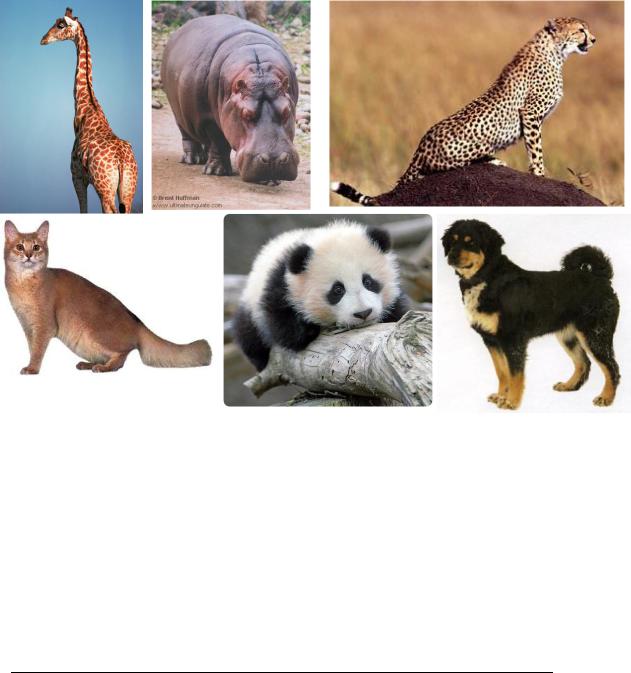
3.h Look at the pictures and compare these animals using as…as, less…than, more…than.
_________________________________________________________________
_________________________________________________________________
_________________________________________________________________
_________________________________________________________________
_________________________________________________________________
_________________________________________________________________
_________________________________________________________________
_________________________________________________________________
________
3.i Tick the correct sentence, as in the example.
1 a: A fish is less noisier than a cat. |
|
b: A fish is less noisy than a cat. |
V |
2a: Lions are not so big as hippos.
b:Lions are not as big as hippos.
3a: Going to the zoo is more entertaining watching TV.
b:Going to the zoo is more entertaining than watching TV.
4a: Cheetahs run faster than zebras.
b:Cheetahs run as fast than zebras.
5 a: Was the film as exciting as the book?
25
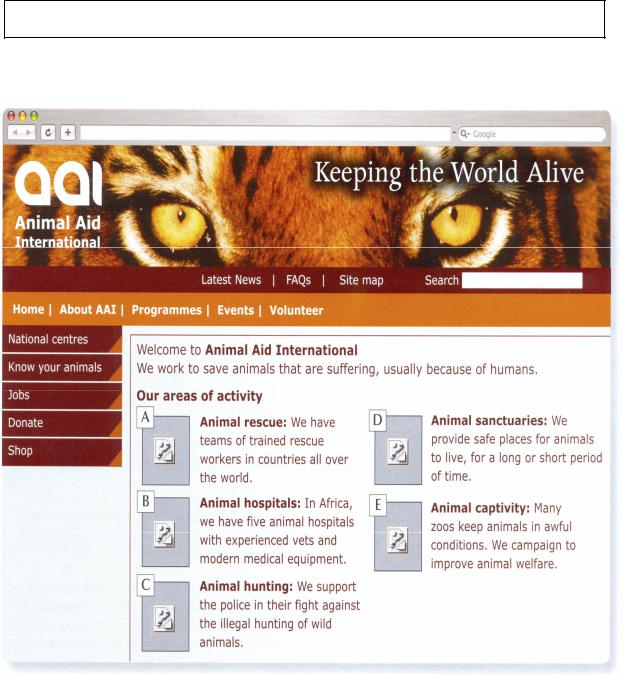
b: Was the film as more exciting as the book?
6a: My hair is less dark than yours.
b:My hair is not as dark as yours.
7a: A zebra’s neck is long as a giraffe’s.
b:A zebra’s neck is not as long as a giraffe’s.
8a: Are dogs more loyal than cats?
b:Are dogs loyal more than cats?
4.Listening
4.a Look at the website below. What kind of organization is it?
a business |
an academic institution |
a charity a government department |
4.b Which link A-E do you click on for the following information?
1 people who kill animals illegally
26
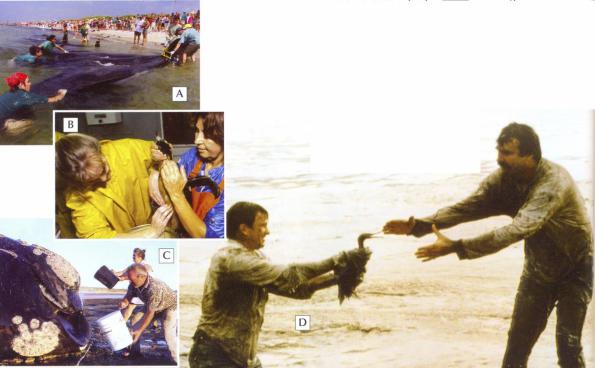
2 special accommodation for animals
3 caring for ill animals
4 animals that are not free
5 saving animals from danger
4.c Listen to the two parts of the conversation and answer the questions.
|
some photos for the new AAI |
1 In what order does Neil describe |
website. He needs to discuss them |
the photos A-D? |
with the Communications Director, |
2 Which photo does he recommend |
Katie. However, she is in the Congo |
for the website? |
and she does not have access to the |
Background information: the AAI |
Internet to view the photos. Neil |
telephones her to describe them and |
|
Website Manager, Neil, is choosing |
make his recommendations. |
4.d Listen to the first part of the conversation again and complete Katie’s notes.
Whale pictures
1)There are 1)______ whales close to a beach. Two men are 2)_______ whale off the beach. Loads of 3)_______ watching.
2)On the left, we can see the large 4)_______ of a whale. Two people throwing 5)_______ on the whale. Pic is 6)________ 1st pic is best – a 7)________ of people working together, they look very 8)_________ - more dramatic.
27

4.e Listen to the second part of the conversation again and complete Katie’s notes.
Bird pictures
1)Man in the 1)______ passing a 2)______ to someone on beach.
2)People 3)______ a bird. Woman in 4)______ shirt holding bird, woman
on the 5)______ cleaning bird.
1st pic more 6)______, makes you 7)______ the situation. 2nd pic shows what experts 8)______, but not very 9)______.
4.f Complete these sentences from the conversation. Then listen again and check.
1.In the first one, _____ are four whales that are close to the beach.
2.There are loads of people _____ the background.
3.On the left of the picture, we can _____ the large head of a whale.
4.On the right, there are two people _____ are throwing water on the whale.
5.They _____ very professional.
6.He’s _____ a bird to someone.
7.The second one _____ some people who are cleaning a bird.
8.The bird’s _____ the middle of the picture.
9.There’s another woman _____ the left.
5.Speaking
Choosing photos for a website
5.a Work with a partner. You are going to role-play a similar situation to the conversation in Listening above.
Student A: You are the Website Manager. Turn to p. 118 and prepare to describe your photos.
Student B: You are the Communications Director. Find out which links the photos are for and take notes.
5.b Swap roles and repeat the role-play.
Student B: You are now the Web Manager. Turn to p. 119.
5.c You are now back in the office. Look at the four photos that your partner described. Was the description good? Do you agree with his/her choice?
USEFUL PHRASES
This one is nicer/clearer/stronger/weaker/more unusual/dramatic/powerful I like the way this one…
I think this one is better because… It makes you feel sad/angry/…
I think we should use this one because…
28
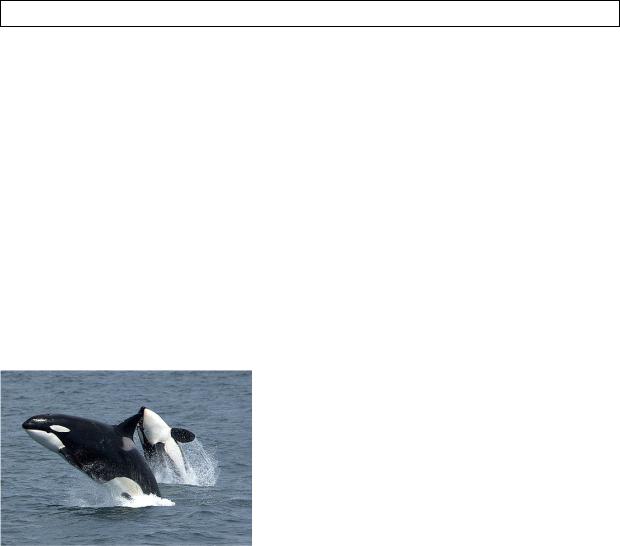
6. Extra Activities
Whale Hunting!
6.a Answer these questions.
1.What do you think the arguments in favour of whale hunting are? And those against it?
2.Why do you think some countries/people are against whale hunting?
3.Why do you think some countries/ people are in favour of whale hunting?
6.b Read the article once to compare your ideas from 6.a.
To kill or not to kill – that is the question for a number of countries
industry, the International Whaling Commission (IWC) was formed in 1946.
However, in 1986, the IWC voted for a temporary ban on whaling. The biggest concern was the huge decline in whale population across the planet. Indeed many people say that the global moratorium came too late and that commercial whaling has already driven many species to the brink of extinction. According to Greenpeace, blue whales (the largest animal on the planet) are at less than 1% of their original
By Sam Gordon
What is the most controversial issue in your country? Whaling is one topic that’s been dividing nations for many years now. Oil from whales lit the lamps of major cities in the US and Europe, and whale oil was used to manufacture soaps, varnish, cosmetics, paint and even the glaze on photographs. In order to oversee the development of the global whaling
abundance in the Antarctic. Sei Whales and Fin Whales are also listed as “endangered species” while Sperm Whales are classified as “vulnerable”.
But there are many other good reasons to oppose whaling. Whales are extremely intelligent mammals. They have social networks very similar to those of humans, and scientists have recently discovered that whales have brain cells only previously found in humans and great apes. On top of that, whaling is also a notoriously cruel industry. Whales are often caught using explosive harpoons that puncture
29
their skin and then explode inside their bodies. In some cases, when the harpoon doesn’t hit its target properly, whales can take minutes or sometimes hours to die.
Despite this, some countries continue to hunt whales. In 1992, Norway declared itself exempt from the ban. And currently Japan hunts more than 1,000 whales a year – all of them part of a supposed “scientific research” programme run by the Japanese Institute of Cetacean Research. Many people argue that this “research” is nothing more than a front for commercial whaling (the meat that is left over after samples are taken is sold as a delicacy). The situation was not helped in 2001, when Maseyuku Komatsu from the Japanese Fisheries Agency described Minke Whales as the “cockroaches of the
sea” in an interview on Australian television.
Many ecological groups have tried to sabotage the hunts. In 2005 and 2006, Greenpeace sent boats to interfere with the whaling fleet in the Antarctic. In some cases, protests have turned violent. Just recently, the Ady Gil (a ship belonging to the Sea Shepherd Conservation Society) was rammed by a whaling ship. The Ady Gil later sank. At present, the world is fairly divided on the issue with Iceland, Japan and Norway on the pro-whaling side, and the US, Australia, New Zealand and the EU on the anti-whaling side. Asked recently how difficult his job was on a scale of one-to-ten, Cristian Maquieira, the chairman of the IWC, said “about a twelve”!
6.c Use your dictionary to match up these words and phrases from the
article with their meanings: |
|
|
|
1. |
whaling |
A |
to do things to try to stop some activity |
2. |
varnish |
B |
a group of boats that are used for hunting |
|
|
|
whales |
3. |
glaze, a ban |
C |
a rare or expensive food |
4. |
a huge decline |
D |
a large brown insect that is found in warm |
|
|
|
places or near food |
5. |
a moratorium |
E |
a weapon like a spear that has a rope |
|
|
|
attached to it |
6. |
to drive something to |
F |
when one activity is hiding another (often |
|
extinction |
|
an illegal one) |
7. |
to the brink of |
G |
to the edge of; almost |
8. |
notoriously |
H |
famously, but for something bad |
9. |
a harpoon |
I |
when an activity is stopped for a period of |
|
|
|
time, usually as a result of an agreement |
10. |
a front |
J |
to destroy something so that it no longer |
|
|
|
exists |
11. |
a delicacy |
K |
a prohibition |
30
